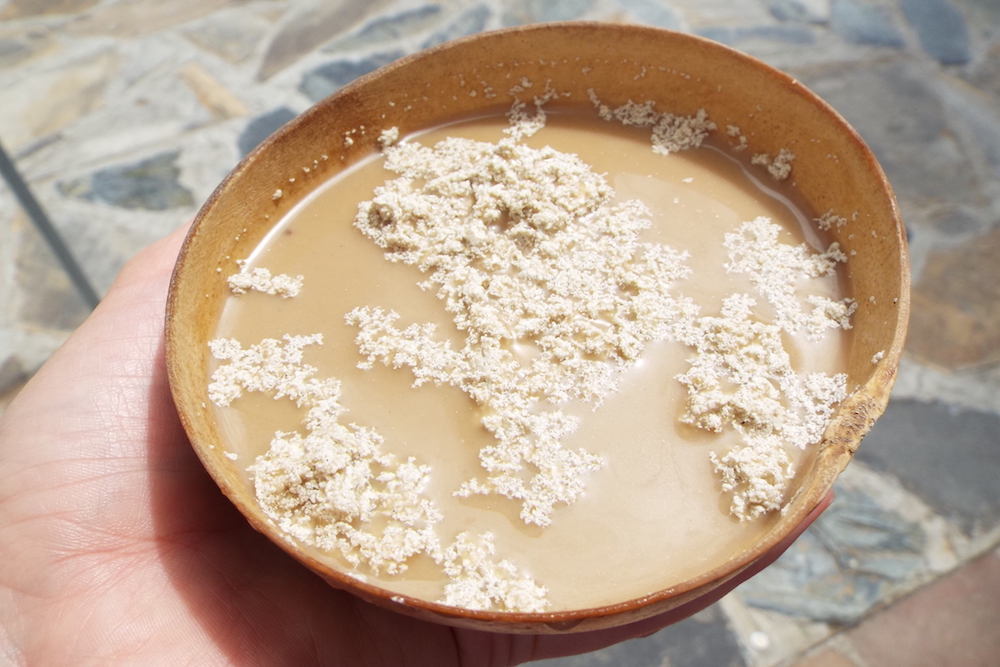So you’ve already been to Mexico. You’re an expert on vitamin T (tacos, tlacoyos, tlayudas…). You fear no salsa. You feel pretty good about your Mexican foodie knowledge. But what about tejate, tepache, and pozol? Ponche, rompope, and a pulque curado? What happens when you find yourself around six steaming metal buckets of atole in a chaotic market at breakfast rush hour?
Mexican cuisine’s refreshing sidekicks get less of the spotlight that its meatier main dishes, but the traditional drinks of Mexico don’t slouch on innovation or taste. Take the following 10 drinks for example, some with histories that date back to the Aztecs, some only found in a single region of the country, but all with a flavor (and texture) you aren’t likely to forget.
Here are a few favorite liquid delights to look for on your next trip south of the border. [pagebreak]
Tejate
This drink is traditional to the state of Oaxaca, where you can find it at roadside stands and in markets served from giant clay bowls, dipped out and poured into your cup using the dried husk of a gourd. The drink is made from ground corn, mamey pits, and cacao flowers. It has a hint of chocolate flavor and a frothy film floating on the top created by the ground cacao flowers.
Hot Chocolate
One of Mexico’s most famous contributions to the world is its chocolate. A blend of spices, nuts, and cacao beans, prepared Mexican hot chocolate tastes of chiles, cinnamon, and the warmth of a bonfire. Traditional Mexican chocolate is always made with water (although you will often be offered water or milk in restaurants) and a molinillo is used to beat the hot chocolate until frothy and thick. Nowadays, sugar is added, but the original recipe was made with honey or vanilla.
Pozol
Dating from the original Maya people of Mesoamerica, pozol is a drink made from ground corn dough and cacao beans and blended with water. Sugar is often added and it is served cool or at room temperature. It’s believed that the ancient peoples of Mexico carried the dough and ground cacao mixed together in pouches as they traveled and mixed it with water when they were hungry or thirsty, as it’s both refreshing and filling. [pagebreak]
Atole
Another drink made from ground corn dough, atole is one of Mexico’s oldest traditional drinks. Modern-day versions may be made with cornstarch but the real-deal corn dough is always better. You’ll find atole most often alongside tamales sold by vendors on cool Mexican mornings. This is an extremely traditional Mexican breakfast and will keep your stomach full till lunch. Try chocolate atole (also called champurrado), rice atole, and atole made from blue corn dough for a special treat.
Tepache
Tepache is a mildly alcoholic drink that results from the fermentation of various types of fruit rinds. Popular versions are made with pineapple, guayaba, orange, or prickly pear mix with hard-packed brown sugar and boiling water and left to ferment for several days (the length of time determines the drink’s acidity and alcoholic content). It’s served cold and is resoundingly refreshing on a hot Mexican afternoon.
Ponche
A special drink made at Christmas time, ponche could be compared to sangria with its boiled blend of various fruit, black tea, and rum, served piping hot and with a hint of clove or cinnamon. The drink is usually garnished with chunks of sugarcane that guests chew on at Christmas posadas – the two weeks of neighborhood parties held right before Christmas each year. The more rum, the more festive you’ll feel! [pagebreak]
Agua Fresca
Agua Frescas are made in every shade of the rainbow and with every fruit at the market. Chopped fruit is mixed with water in a blender, sometimes strained, sometimes not, and served cold. Favorites of locals include hibiscus flower, tamarind, watermelon, and honeydew. Any local Mexican restaurant worth its salt will have at least one agua fresca offered daily on its menu, so be careful when ordering. If you say “agua,” the waiter will most likely ask you “what flavor?”
Rompope
This creamy, sweet drink can be found throughout the year, but is particular popular at Christmas, much like eggnog in the United States. The recipe includes eggs, milk, sugar, cinnamon, and rum or brandy. Just like eggnog, it’s a drink that sneaks up on you. It’s so delicious you might have a few too many before you realize it.
Cafe de Olla
You will find piping hot cafe de olla everywhere from the sweltering heat of the Pacific coast’s fish markets to the blustering roadside stands of Central Mexico’s mountains. This favorite for any time of the day is coffee boiled (in an olla or pot) with sticks of cinnamon and packed brown sugar (piloncillo). The coffee comes out sweet and fragrant, at a weak to medium strength. There is nothing like a cup of cafe de olla and a hot quesadilla after a cool morning hike or to sweat out a hangover.
Pulque Curado
The Aztecs’ famous “drink of the gods,” pulque, converts itself into a crowd pleaser by becoming a pulque curado: white, yeasty, natural pulque mixed with fruit juices or nut or grain “milks.” The Bajio region of Mexico sells incredible prickly pear pulque in the fall and all year round in Mexico City you can find everyone from young hipsters to aging farmers drinking a cup.


![Making Mealtime Matter with La Familia: Easy Sofrito [Video]](https://thelatinkitchen.com/wp-content/uploads/2015/10/sofrito-shutterstock__0-500x383.jpg)
![Easy Latin Smoothies: Goji Berry Smoothie [Video]](https://thelatinkitchen.com/wp-content/uploads/2015/12/goji_berry-shutterstock_-500x383.jpg)
















![Fun and Fast Recipes: Fiesta Cabbage Salad [Video]](https://thelatinkitchen.com/wp-content/uploads/2015/11/fiesta_cabbage_slaw-shutterstock_-500x383.jpg)









